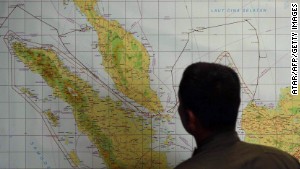Results 1 to 2 of 2
Thread Information
Users Browsing this Thread
There are currently 1 users browsing this thread. (0 members and 1 guests)
-
03-13-2014, 09:12 PM #1
Missing Flight Left Data Trail - Plane stolen?
Missing Flight Left Data Trail
Jetliner 'Pinged' Satellites With Location, Altitude for Hours After Disappearance
By JON OSTROWER,
ANDY PASZTOR and
JULIAN E. BARNES
CONNECT
Updated March 13, 2014 8:43 p.m. ET
WSJ has confirmed that the pilot had the ability to manually turn off the transponder on Flight MH370. Why is the transponder so significant? WSJ's Jason Bellini has #TheShortAnswer.
Communication satellites received intermittent data "pings" from a missing Malaysia Airlines 3786.KU -4.08% jet, giving the plane's location, speed and altitude for at least five hours after it disappeared from civilian radar screens, people briefed on the investigation said Thursday.
The final satellite ping was sent from over water, at what one of these people called a "normal" cruising altitude. The people declined to say where specifically the transmission originated, adding that it was unclear why the transmissions stopped. One possibility one person cited was that the system sending them had been disabled by someone on board.
The automatic pings, or attempts to link up with satellites operated by InmarsatISAT.LN -1.32% PLC, occurred a number of times after Malaysia Airlines Flight 370's last verified position, these people said, indicating that at least through those hours, the BoeingCo. BA -2.04% 777 carrying 239 people remained intact and hadn't been destroyed in a crash, act of sabotage or explosion.
Malaysian Airlines said it hadn't received any such data.

Chicago-based Boeing declined to comment Thursday.
If the plane remained airborne for that entire period it could have flown more than 2,200 nautical miles from its last confirmed position over the Gulf of Thailand, these people said.
On Thursday, meanwhile, the international search for the plane zeroed in on areas far west of the plane's last known location.
Cmdr. William Marks, the spokesman for the U.S. Seventh Fleet, said the USS Kidd would move through the Strait of Malacca, on Malaysia's west coast, and stay at its northwest entrance, while surveillance planes would search an area of the Indian Ocean 1,000 miles or more west of the strait.
Malaysia, which is overseeing the search effort, directed Indian forces to a specific set of coordinate in the Andaman Sea, northwest of the Malay peninsula, an Indian official said Thursday.
"There was no specified rationale behind looking in those areas, but a detailed list was provided late Wednesday evening," the Indian official said.
U.S. aviation investigators said they were analyzing the satellite transmissions to determine whether they can glean information about the plane's location or status. The transmissions were sent via onboard technology designed to send routine maintenance and system-monitoring data back to the ground via satellite links, according to people familiar with the matter.

A woman in Kuala Lumpur writes a message with others expressing prayers and well-wishes for the missing jet. Agence France-Presse/Getty Images
Among the possible scenarios investigators said they are now considering is whether the jet may have landed at any point during the five-hour period under scrutiny, or whether it ultimately crashed.
The people said aviation investigators are exploring the possibility that someone on the plane may have intentionally disabled two other automated communication systems in an attempt to avoid detection. One system is the transponders, which transmit to ground radar stations information on the plane's identity, location and altitude, and another system that collects and transmits data about several of the plane's key systems.
The widebody jet was scheduled to fly overnight to Beijing from Kuala Lumpur in the predawn hours of March 8. Its transponders last communicated with Malaysian civilian radar about an hour after takeoff.
After the plane dropped off civilian radar screens, these people said, the satellite link operated in a kind of standby mode for several hours and sought to establish contact with a satellite or satellites. These transmissions didn't include data about any of the plane's critical systems, they said, but the periodic contacts indicate to investigators that the plane was still intact and believed to be flying at least a significant portion of that time. The people said the transmissions included detailed information about the plane's location, speed and bearing.
The transmissions, one person said, were comparable to the plane "saying I'm here, I'm ready to send data."
Unknown so far to investigators is what happened to the plane following the final satellite ping, these people said. Questions remain about the plane's status, including what was happening in the cockpit.
Former FBI agent Chris Voss joins the News Hub to discuss U.S. investigators' suspicions that Malaysia Airlines Flight 370 stayed in the air for four hours after vanishing from civilian air-traffic control radar.
But the huge uncertainty about where the plane was headed, and why it apparently continued flying so long without working transponders and other communication links, has raised theories among investigators that the aircraft may have been commandeered for reasons that remain unclear to U.S. authorities.
At one briefing, according to this person, officials were told that investigators are actively pursuing the notion that the plane was diverted "with the intention of using it later for another purpose."
As authorities scramble to analyze and understand all of the transmissions from the missing 777, the situation continues to change rapidly. Some people briefed on the issue initially described the transmissions as information that had been relayed from onboard monitoring systems embedded in the two Rolls-Royce PLC Trent 800 engines, not the idling satellite communications system.
—Trefor Moss, Gaurav Raghuvanshi, Josh Chin and Jeremy Page contributed to this article..
http://online.wsj.com/news/articles/...396580350.html
-
03-13-2014, 09:18 PM #2
VIDEO REPORT AT LINK
Officials: Malaysian plane may have flown long after last contact
From Barbara Starr, Jim Sciutto and Catherine E. Shoichet, CNN
updated 8:41 PM EDT, Thu March 13, 2014
Source: CNN
(CNN) -- It's a mystery that authorities still haven't been able to solve: Where is Malaysia Airlines Flight 370?
There were still more questions than answers Thursday as U.S. officials said investigators might start combing the Indian Ocean as they look for the missing aircraft.
Why would authorities expand their search rather than narrowing it?
New information, U.S. officials told CNN, indicates the missing airplane could have flown for several hours beyond the last transponder reading.
Malaysian authorities believe they have several "pings" from the airliner's service data system, known as ACARS, transmitted to satellites in the four to five hours after the last transponder signal, suggesting the plane flew to the Indian Ocean, a senior U.S. official told CNN. That information combined with known radar data and knowledge of fuel range leads officials to believe the plane may have made it to that ocean, which is in the opposite direction of the plane's original route.
"There is probably a significant likelihood" that the aircraft is now on the bottom of the Indian Ocean, the official said, citing information Malaysia has shared with the United States.
It's the latest twist in a case that's baffled investigators and grabbed global attention for days. Information about the missing flight has been hard to come by, and numerous leads have been revealed by some officials only to be debunked by others hours later.
 Mystery of Flight 370 continues
Mystery of Flight 370 continues
 Photos may show missing plane ... now what?
Photos may show missing plane ... now what?
 Remembering victims amid flight confusion
Remembering victims amid flight confusion
 Flight 370: The mysterious trail
Flight 370: The mysterious trail
There are conflicting reports about this latest lead as well.
Earlier Thursday the Malaysian government denied a Wall Street Journal report that the plane was transmitting data after the last transponder signal.
And a senior aviation source with detailed knowledge of the matter also told CNN's Richard Quest on Thursday that there was no technical data suggesting the airplane continued flying for four hours, and said specifically that the Wall Street Journal account was wrong.
But U.S. officials maintained Thursday afternoon that the information from the airplane's data system was being actively pursued in the plane investigation.
Analysts from U.S. intelligence, the Federal Aviation Administration and the National Transportation Safety Board have concluded that pings sent to a satellite hours after the plane's last transponder signal likely came from the missing aircraft, the senior U.S. official said.
"It appears the plane was flying most of that time," the senior U.S. official said. The "indication" that the plane kept flying is not based on U.S. government information but rather based on radar readings and plane data.
There is reason to believe the plane flew for four hours, the officials said, but there is no specific indication where the plane actually is.
Multiple bursts of data were received indicating the plane was flying over the Indian Ocean, the senior U.S. official told CNN.
And there's another confusing twist. An emergency beacon that would have sent data if the plane was about to impact the ocean apparently did not go off, the official said. The beacons, known as Emergency Locator Transmitters, activate automatically upon immersion in fresh or salt water, but must remain on the surface for a distress signal to transmit.
The failure of the beacon to activate could mean that the plane didn't crash, that the transmitter malfunctioned, or that it's underwater somewhere.
This new information has now led to a decision to move the USS Kidd into the Indian Ocean to begin searching that area, the official said.
The Navy destroyer is now on its way there at the request of the Malaysian government, Cmdr. William Marks of the U.S. 7th Fleet told CNN's Wolf Blitzer Thursday.
"We're not out here freelancing, and it's not just something the U.S. Navy thinks and no one else," Marks said. "So this was by request of the Malaysian government. They asked the Navy to move our ship to the west into the Strait of Malacca. ... It is coordinated, but certain ships and aircraft stay in the east, and some go to the west. And we're moving to the west."
Mary Schiavo, former inspector general for the U.S. Department of Transportation, said even though it's unclear how accurate the latest information is, authorities have no choice but to pursue it.
"Well I think basically given that there is some information -- how reliable or not -- we have to respond," she said. "There is no way we cannot follow up on this lead. It would be inhumane. And it might turn out to be just the lead we need. ... There isn't much, but I think we have to do it."
So are we any closer to knowing whether a mechanical problem, terrorism or hijacking could be tied to the plane's disappearance?
Not really, said Evy Poumpouras, a former Secret Service agent.
"The sad thing here is, we don't have enough information to say, 'It's not this, it's not that,'" she told CNN's Don Lemon. "We're still at the point, six days later, it could be anything, and that's the frustrating thing."
Analyst: 'Deliberate act' shut down communication
An ABC News report added another twist to the mystery Thursday evening. Citing two unnamed U.S. officials, the network said two separate communications systems on the missing aircraft were shut down separately, 14 minutes apart.
The officials told ABC they believe the plane's data reporting system was shut down at 1:07 a.m. Saturday, while the transponder transmitting location and altitude was shut down at 1:21 a.m.
"This is beginning to come together to say that ...this had to have been some sort of deliberate act," ABC aviation analyst John Nance told CNN's Erin Burnett.
White House spokesman Jay Carney didn't go into details when he discussed the search for the plane Thursday, but he said "some new information that's not necessarily conclusive" could lead U.S.
searchers to the Indian Ocean.
"We are looking at information, pursuing possible leads, working within the investigation being led by the Malaysian government, and it is my understanding that one possible piece of information or collection of pieces of information has led to the possibility that a new search area may be opened," Carney said.
Originally, a report from The Wall Street Journal said data from the plane's Rolls-Royce engine had raised questions among some U.S. officials about whether the plane had been steered off course "with the intention of using it later for another purpose," the newspaper reported, citing a "person familiar with the matter."
The newspaper later corrected its story, saying that data leading investigators to believe the plane had flown for up to five hours came from the plane's satellite-communication link, which the newspaper said is "designed to automatically transmit the status of certain onboard systems to the ground."
Malaysia's acting Transportation Minister Hishammuddin Hussein rejected the Wall Street Journal report at a news conference Thursday, reiterating that the plane sent its last transmissions at 1:07 a.m. Saturday.
And Malaysia Airlines Chief Executive Ahmad Jauhari Yahya said that Rolls-Royce and Boeing have reported that they didn't receive transmissions of any kind after 1:07 a.m. Saturday. Air traffic controllers lost contact with the plane shortly afterward, around 1:30 a.m.
Erin Atan, a spokeswoman for Rolls-Royce in Asia, declined to comment on the matter, telling CNN it was "an official air accident investigation."
Authorities have not ruled out the possibility the plane continued to fly, however. And given the lack of evidence, all options remain on the table.
The report threatened to open the door to a fresh round of theories about what has become of the plane, which vanished while flying over Southeast Asia on its way from Kuala Lumpur to Beijing.
Four more hours in the air could have put the plane many hundreds of miles beyond the area currently being searched.
But one aviation industry observer expressed skepticism about the report even before the denials by officials.
"I find this very, very difficult to believe," Tom Ballantyne, chief correspondent for the magazine Orient Aviation, told CNN. "That this aircraft could have flown on for four hours after it disappeared and not have been picked up by someone's radar and not have been seen by anyone, it's almost unbelievable."
See more of our coverage on missing Malaysia Airlines Flight 370
Search getting harder
The news came after Vietnamese and Chinese search crews found nothing where Chinese satellite photographs released Wednesday showed large floating objects in the South China Sea.
The spot is between Malaysia and Vietnam and not far from the plane's expected flight path.
China's State Administration for Science, Technology and Industry for National Defense described the images as showing "a suspected crash site."
But Chinese authorities later said the release of the satellite images was a mistake and that they didn't show any debris relating to the plane, Hishammuddin said.
The mystery over the fate of the passenger jet, a Boeing 777-200, and the 239 people it was carrying has so far left government officials and aviation experts flummoxed.
"With every passing day the task becomes more difficult," Hishammuddin said.
Searchers have already been combing a vast area of sea and land for traces of the plane. But so far, with the search well into its sixth day, their efforts have been fruitless.
Malaysian officials say they are still trying to determine if a radar blip detected heading west soon after the plane lost contact was in fact the missing jet.
If it was, the plane would have been hundreds of miles off its original flight path and headed in the wrong direction. Malaysian officials say they have asked U.S. experts to help them analyze the radar data.
Meanwhile, India is joining the multinational search, dispatching two of its naval ships off the remote Andaman and Nicobar islands, a military spokesman told CNN.
Last known words
Also on Thursday, a Malaysian aviation official told CNN that the last known words from the flight crew of the missing plane were "All right, good night."
Malaysian civil aviation officer Zulazri Mohd Ahnuar said he couldn't confirm which member of the flight crew sent the message, which was transmitted from the plane back to Malaysian flight controllers as the aircraft transferred into Vietnamese airspace early Saturday.
For the families of those on board the missing plane, the wait for news is torturous.
Danica Weeks is trying to keep it together for her two young sons, though the possibility of life without husband Paul, who was on the plane, is sometimes overwhelming. She's clinging to hope even though, as Weeks told CNN's Piers Morgan, it's "not looking good."
"Every day, it just seems like it's an eternity, it's an absolute eternity," Weeks said from Australia. "We can only go minute by minute ... and hope something comes soon."
CNN's Pamela Brown, Michael Pearson, Jethro Mullen, Sarah Aarthun, Elizabeth Joseph, Brian Walker, Simon Harrison, Greg Botelho and Harmeet Shah Singh contributed to this report.
http://www.cnn.com/2014/03/13/world/asia/malaysia-airlines-plane/


 LinkBack URL
LinkBack URL About LinkBacks
About LinkBacks




 Reply With Quote
Reply With Quote


Arizona GOP pushing tough, new border policies, but faces strong...
05-05-2024, 10:24 AM in illegal immigration News Stories & Reports